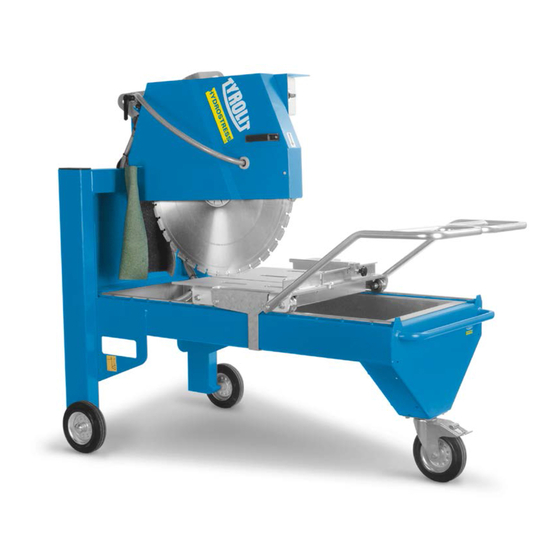
Subscribe to Our Youtube Channel
Summary of Contents for TYROLIT Hydrostress TME700P
-
Page 1: Spare Parts List
Operating manual Spare parts list Stone cutoff saw TME700P Index «000» 10995348 en I 16.07..2015... - Page 2 Fax +41 44 952 18 00 e-mail: info@tyrolit.com www.hydrostress.com TYROLIT Hydrostress AG reserves the right to make technical changes without prior notice. Copyright© 2014 TYROLIT Hydrostress AG, CH-8330 Pfäffikon ZH, Switzerland All rights reserved, in particular copyrighting and translating rights.
-
Page 3: Table Of Contents
Preface to the operating manual This operating manual makes it easier to become familiar with the machine and to use it properly. The operating manual contains important information on how to operate the machine safely, properly and efficiently. Following the operating manual helps avoid danger, avoid repair costs and downtime, and increase the machine's reliability and life. -
Page 4: Basic Safety Instructions
1. Basic safety instructions Warnings and symbols in this manual Danger! Points out that serious or even fatal injuries may result if not followed. Caution! Points out that injuries may result if not followed. Notice! Points out that damage to the machine or other equipment may result if not followed. - Page 5 1.3.4 Check at least from time to time whether personnel are performing the work in compliance with the operating manual and paying attention to risks and safety factors! Caution! 1.3.5 Use personal protective equipment where necessary or if required by regulations. Danger! 1.3.6.
- Page 6 Safety instructions during specific operating phases 1.5.1 Normal operation 1.5.1.1 Avoid all actions and working methods which may compromise safety. Danger! 1.5.1.2 Take steps to ensure that the machine is operated only in a safe and proper condition! 1.5.1.3 Check the machine for visible external damage and defects at least once per shift. lmmediately report any changes (including in operational performance) to the appropriate office/individual! lf necessary, stop the machine immediately and make it secure.
- Page 7 Note 1.5.2.4 Before cleaning the machine with water or other cleaning agents, cover/seal all openings that, for reasons of safety and/or functioning, water/steam/cleaning agents must not be allowed to enter. Particularly endangered are electrical motors, switches and plug connections. Cleaning with a steam jet is not permitted.
- Page 8 1.7 Transport Danger! 1.7.1 Use a four ring suspension gear of sufficient carrying force when dislocating the machine. Danger! 1.7.2 Determine an expert to give the appropriate handling instructions for the lifting procedure! Danger! 1.7.3 Lift machine according to the instructions as provided in the operation manual (stop points for load carrying devices etc.) by means of the lifting gear in a workmanlike manner! Danger! 1.7.4 Use only suitable transport vehicles with sufficient lifting capacities!
-
Page 9: Machine Description
2. Machine description Overview of components ltem 1 Frame ltem 2 Water tub ltem 3 Saw table ltem 4 Switchbox ltem 5 Saw hood ltem 6 Motor ltem 7 Cutting height adjustment ltem 8 Saw blade ltem 9 Saw head ltem 10 Emergency switch ltem 11 Connector plug ltem 12 Switch... -
Page 11: Assembly And Initial Preparation For Operation
Noise emission values The measurements were made in accordance to the norms EN ISO 3744, EN ISO 11201 and EN 12418. Therefore it was used a standard saw blade Type W3 0700 mm (not a silent blade). Parameter Value continuous sound 91 dB (A) pressure level at work LoA... -
Page 13: Transport
Test direction of rotation of the saw blade - Press the switch start (15). - Switch the Star-delta-switch (item 12) short to "Star''. - Check the direction of rotation of the saw blade. The direction of rotation is clockwise, seen from the left (direction arrow on the saw hood). -
Page 15: Operation
5. Operation Setting up the saw - Set up the saw on a clean and stable foundation. - Test the saw's steadiness. Saw preparations (see 3.4) Test the direction of rotation of the saw blade (see 3.5) 5.4 Changing direction of rotation (see 3.6) 5.5 Sawing (see 3.7) 5.6 Cutting guality of the saw blade lf the saw blade looses its sharpness after langer use, you can "sharpen"... -
Page 16: Maintenance
7. Maintenance - Thoroughly clean the saw once per week (in off circuit condition) 8. Malfunctions Malfunction Possible cause Remedv Motor does not run - Power cord is defective New power cord - Motor is defective - Switch is defective May only be repaired by an electrician lncorrect saw blade rotation direction...

















Need help?
Do you have a question about the TME700P and is the answer not in the manual?
Questions and answers